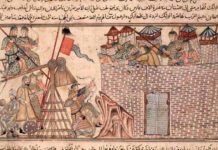
“Medicine is a science from which one learns the states of the human body with respect to what is healthy and what is not, in order to preserve good health when it exists and restore it when it is lacking.”
These practical and reasonable words were put on paper in the 11th century by one of the greatest of all Muslim physicians, Abu Ali al’Husain ibn Abdullah ibn Sina, better known to the Western world as Avicenna. They supplied the opening to his book titled, The Canon of Medicine. In the 12th century his book was translated into Latin and became the most popular and widely used medical textbook in Europe, the Islamic world and Asia for the next 500 years, to only be replaced by the new science which emerged from the Renaissance. The influence of Avicenna’s work can be seen today in the large number of physician’s resource groups which bear his name throughout the world.
Avicenna was born in Central Asia in 980 to a father who not only oversaw his son’s education, but introduced him to many of the leading intellectuals of the day. He studied philosophy among many other things, but gained immense skill and knowledge in the field of medicine. So much so that at the age of 17 he cured the King of Bukhara of an illness no other physician had been able to touch. As a reward for his service, the young man was allowed access to the king’s Royal Library where he furthered his studies.
When his father died, Avicenna began traveling, working as a physician in various towns. In his travels he met and later corresponded with a famous scholar, Al-Biruni, who was influential in the fields of mathematics, history, astronomy, physics and medicine. He also became involved in politics, being appointed vizier by the prince of Hamadan in Persia. After the prince died, Avicenna took to wandering again and ended up in Isfahan in the service of the ruler, Ala ad-Daula. He remained a constant companion to the ruler, accompanying him on journeys and military campaigns and on one of these journeys became ill and subsequently died in 1037 in Hamadan.
During his years of service in Isfahan, Avicenna found time to study more philosophy, medicine, mathematics and astronomy, becoming a leading authority. He published anywhere from 100 to 250 books on these subjects (accounts vary), though two works would become his most famous. The first, The Book of Healing was an encyclopedia which included the fields of psychology, natural sciences, mathematics, astronomy and music. The second, The Canon of Medicine has been called the most famous medical textbook in history.
While it has been acknowledged that Muslim scholars kept much of the ancient scientific and philosophical teachings alive during Europe’s “Dark Ages,” it has also been claimed that the Muslim physicians and scientists of Avicenna’s time merely recorded the existing medical knowledge and translated the Greek works without adding much new material. This is inaccurate. Avicenna’s Canon not only included translations from the Greek works of Hippocrates of Cos and Galen, it added much from the medical knowledge of the world of Islam, including Syria and Persia as well as works from India. Avicenna himself included much of his own findings and work. His original contributions included, among many other things, the relationship between psychology and health, which modern medicine has only acknowledged in fairly recent times. He also provided the most comprehensive treatment of pharmacology ever, including descriptions of 760 drugs and their uses.
If Avicenna had been born later, we would now call him the epitome of the “Renaissance Man,” or at least by the definition with which we now use that term. He made original, accurate and important discoveries in mathematics and astronomy, studied philosophy to great effect, observed and studied many forces and concepts in physics, denied the prevailing view of transmutation in chemistry, and contributed greatly to music theory. In short, he can be compared to the great Leonardo da Vinci in the scope and brilliance of his work, and it can only be a quirk of history, or perhaps the fact that he left few visual records of his work, that the one is far more famous than the other.







